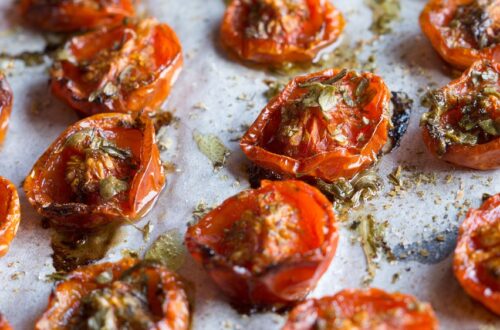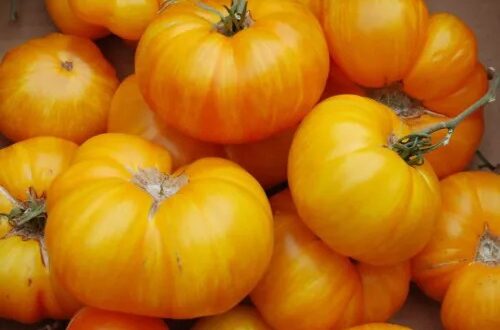
The Difference Between Hybrid and Heirloom Tomatoes: A Gardener’s Guide
Have you ever strolled through the farmers’ market or perused seed catalogs, only to be bombarded by terms like “hybrid” and “heirloom” when it comes to tomatoes? If you’ve ever wondered what these words mean and how they affect your gardening choices, you’re in the right place! Understanding the differences between hybrid and heirloom tomatoes can help you make the best decision for your garden, ensuring you grow the tastiest, healthiest, and most suitable tomatoes for your needs.
In this comprehensive guide, we’ll explore what sets hybrid and heirloom tomatoes apart, from their origins and characteristics to the benefits and challenges each type presents. Whether you’re a seasoned gardener or just starting, this article will provide you with the knowledge to choose the perfect tomatoes for your garden.
What Are Hybrid Tomatoes?

1. Definition and Origins
Hybrid tomatoes are the result of intentional crossbreeding between two different tomato varieties. This process is carried out by plant breeders who aim to combine specific traits from each parent plant to create a new variety with desirable characteristics. These characteristics might include disease resistance, higher yield, uniform fruit size, or improved shelf life.
The crossbreeding process that creates hybrid tomatoes involves controlled pollination, where pollen from one variety is transferred to the flower of another. The seeds produced from this cross will grow into hybrid plants that display the traits the breeders were aiming for. However, the seeds from hybrid tomatoes do not grow true to type if saved and replanted, meaning they won’t produce plants identical to the parent hybrid.

2. Characteristics of Hybrid Tomatoes
Hybrid tomatoes are often bred to meet the specific needs of commercial growers and home gardeners alike. Here are some key characteristics:
- Uniformity: Hybrid tomatoes typically produce fruits that are consistent in size, shape, and color, making them visually appealing.
- Disease Resistance: Many hybrids are bred to resist common tomato diseases like blight, fusarium wilt, and nematodes. This makes them a reliable choice for areas where these issues are prevalent.
- High Yield: Hybrid plants often produce more tomatoes per plant than heirlooms, which is advantageous for those looking to maximize their harvest.
- Improved Shelf Life: Some hybrid varieties are bred to have thicker skins or firmer flesh, which can extend their shelf life and make them easier to transport.

3. Popular Hybrid Varieties
Some well-known hybrid tomato varieties include:
- ‘Better Boy’: Known for its excellent disease resistance and high yield, ‘Better Boy’ produces large, juicy tomatoes perfect for slicing.
- ‘Celebrity’: This hybrid is highly disease-resistant and produces medium-sized fruits with a rich, classic tomato flavor.
- ‘Roma VF’: A popular paste tomato, ‘Roma VF’ is resistant to verticillium and fusarium wilts, making it a reliable choice for making sauces and canning.
What Are Heirloom Tomatoes?

1. Definition and Origins
Heirloom tomatoes are varieties that have been passed down through generations, often within a family or community. To be considered an heirloom, a tomato variety must be open-pollinated, meaning it relies on natural pollinators like bees or wind, rather than human intervention. Heirloom varieties have remained unchanged for at least 50 years, often much longer, preserving their original characteristics.
Heirloom tomatoes are prized for their rich history and unique flavors. They come in a wide range of colors, shapes, and sizes, each with its own story to tell. Unlike hybrids, the seeds from heirloom tomatoes can be saved and replanted year after year, producing plants that are true to type.
2. Characteristics of Heirloom Tomatoes
Heirloom tomatoes are celebrated for their diverse and often superior flavor profiles, but they also come with their own set of challenges:
- Flavor: Heirloom tomatoes are often considered to have more complex and intense flavors than hybrids, ranging from sweet to tangy to smoky.
- Diversity: With heirlooms, you’ll find tomatoes in nearly every color of the rainbow—red, yellow, orange, green, purple, and even striped varieties.
- Shape and Size: Heirlooms can be round, pear-shaped, or lobed, with sizes ranging from tiny cherry tomatoes to massive beefsteaks.
- Susceptibility to Disease: Unlike hybrids, heirlooms have not been bred for disease resistance, making them more vulnerable to issues like blight and cracking.
- Lower Yield: Heirloom plants often produce fewer fruits per plant compared to hybrids, but many gardeners find the superior flavor well worth the trade-off.

3. Popular Heirloom Varieties
Some beloved heirloom tomato varieties include:
- ‘Brandywine’: This large, pink tomato is known for its rich, sweet flavor and is often considered the gold standard of heirlooms.
- ‘Cherokee Purple’: With its deep, dusky purple color and complex flavor, ‘Cherokee Purple’ is a favorite among tomato connoisseurs.
- ‘Green Zebra’: This eye-catching tomato is green with yellow stripes and has a zesty, tangy flavor that stands out in salads.
Key Differences Between Hybrid and Heirloom Tomatoes

1. Breeding and Seed Saving
The most fundamental difference between hybrid and heirloom tomatoes lies in their breeding and seed-saving potential:
- Hybrids: Created through controlled crossbreeding, hybrids do not breed true from saved seeds. If you save seeds from a hybrid tomato, the resulting plants will likely produce tomatoes with different characteristics from the parent plant.
- Heirlooms: These are open-pollinated and will produce seeds that can be saved and replanted, yielding plants identical to the parent plant.
2. Flavor and Diversity
- Hybrids: While some hybrids are bred for flavor, many are designed for traits like uniformity, shelf life, and disease resistance, sometimes at the expense of taste. Hybrid tomatoes tend to be more uniform in appearance but less diverse in flavor.
- Heirlooms: Heirloom tomatoes are celebrated for their exceptional and varied flavors. They offer a more diverse range of colors, shapes, and sizes, making them a favorite for those who prioritize taste and variety in their garden.
3. Disease Resistance and Hardiness
- Hybrids: One of the main advantages of hybrids is their resistance to specific diseases, which can make them easier to grow, especially in challenging climates or regions prone to certain tomato ailments.
- Heirlooms: Heirloom varieties are generally more susceptible to diseases and environmental stresses, which can make them more challenging to grow. However, many gardeners are willing to take on this challenge for the reward of their unique flavors and histories.
4. Yield and Production
- Hybrids: Typically, hybrids are bred to produce a higher yield, which is ideal for those looking to maximize their harvest, especially in smaller spaces or commercial settings.
- Heirlooms: Heirlooms may produce fewer fruits per plant, but the focus is often on quality over quantity. The fruits they do produce are typically more flavorful and varied.
5. Cultural and Historical Significance
- Hybrids: While hybrids are valuable for their practical benefits, they don’t carry the same cultural or historical significance as heirlooms. They are more a product of modern agricultural practices.
- Heirlooms: Heirloom tomatoes are often treasured for their historical and cultural value, with some varieties having been cultivated for hundreds of years. Growing heirlooms is like growing a piece of history in your garden.

When to Choose Hybrid Tomatoes
Hybrid tomatoes are an excellent choice for gardeners who prioritize reliability, disease resistance, and higher yields. If you’re growing tomatoes in an area with known disease issues, or if you want a consistent crop with uniform fruits, hybrids may be the way to go.
1. Urban and Container Gardening
For those gardening in small spaces or containers, hybrids can offer compact plants with high yields. Varieties like ‘Patio Princess’ are designed specifically for small spaces, providing delicious tomatoes on a manageable plant.
2. Short Growing Seasons
If you live in a region with a short growing season, hybrid varieties that mature quickly can ensure you get a bountiful harvest before the first frost.
3. First-Time Gardeners
New gardeners may find success with hybrids due to their resilience and ease of growth. Hybrids like ‘Early Girl’ are known for their early and reliable production, making them a good choice for beginners.
When to Choose Heirloom Tomatoes
Heirloom tomatoes are the perfect choice for gardeners who value flavor, diversity, and a connection to the past. If you’re looking to grow unique and delicious tomatoes, and you don’t mind a bit of extra care, heirlooms are an excellent choice.
1. Flavor Enthusiasts
If taste is your top priority, heirlooms offer a depth and variety of flavors that hybrids often can’t match. Growing a mix of heirloom varieties can provide a tomato for every culinary need, from sweet and juicy slicers to tangy sauce tomatoes.
2. Seed Saving and Sustainability
For those interested in sustainable gardening practices, heirlooms allow you to save seeds and reduce the need to purchase new seeds each year. By growing and saving heirloom seeds, you’re also helping to preserve plant biodiversity.
3. Heritage and History
Gardeners with an appreciation for history and culture may enjoy growing heirloom varieties that have been passed down through generations. Many heirlooms come with stories that add a meaningful dimension to your gardening experience.

Growing Tips for Both Hybrid and Heirloom Tomatoes
1. Soil Preparation
Both hybrids and heirlooms thrive in well-drained, nutrient-rich soil. Before planting, work in plenty of compost or aged manure to ensure your tomatoes have the nutrients they need to grow strong and healthy.
2. Proper Watering
Tomatoes require consistent watering, especially during fruit set. Water deeply at the base of the plant to encourage deep root growth and avoid watering the foliage, which can lead to disease.
3. Support Structures
Tomatoes, whether hybrid or heirloom, benefit from support structures like stakes, cages, or trellises. Supporting your plants helps prevent them from sprawling on the ground, which can lead to disease and pest issues.
4. Pruning and Maintenance
Regularly prune your tomato plants to remove suckers and improve air circulation. This is especially important for heirlooms, which can be more susceptible to disease.
5. Mulching
Mulching around the base of your plants can help retain moisture, suppress weeds, and prevent soil-borne diseases from splashing onto the leaves.
6. Harvesting
Harvest tomatoes when they are fully ripe and have developed their full color. Heirlooms, in particular, should be picked when they reach their peak flavor, which may require checking the plants daily during the height of the season.
Understanding the differences between hybrid and heirloom tomatoes allows you to make informed decisions that suit your gardening goals and preferences. Whether you choose hybrids for their reliability and yield, or heirlooms for their flavor and history, each type brings its own unique benefits to your garden. By selecting the right varieties and following good gardening practices, you can enjoy a bountiful harvest of delicious tomatoes that reflect the time and care you’ve invested in your garden.



